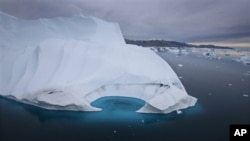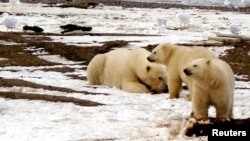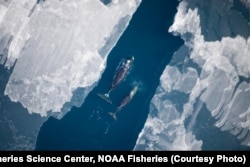In the darkness of an Arctic noon, a blast of (relatively) warm air blew over a buoy very near the North Pole this Wednesday. For a brief time, the temperature rose above freezing.
The storm system that dumped record-breaking rain on England this week had flung a mass of warm, southern air over the North Pole, pushing the temperature more than 30 degrees Celsius above normal.
It's not the first time it's been this warm up there this late in the year. Since 1948, the planet's northernmost reaches have seen above-freezing temperatures in three other Decembers, according to a tweet from Weather Underground meteorologist Bob Henson.
"By itself, it's not that meaningful," said Columbia University oceanographer Robert Newton.
But there's a lot more going on in the Arctic that has scientists worried.
The year 2015 has been the region's warmest on record. That's true for the planet as a whole, too. But while the average global temperature has risen 1 degree Celsius since pre-industrial times, the Arctic is up 3 degrees.
"The Arctic is warming faster than any other part of the planet,” Newton said. “And the Arctic is warming much faster than we thought it would. And it's warming even faster than most of our models predict it will.”
For five of the past six years, Arctic snow cover has been below 3 million square kilometers, a threshold that was never crossed in the previous 43 years. Sea ice cover was the fourth-lowest last year since records began in 1979. The lowest was in 2012.
So Wednesday's above-freezing temperature was "not just a single freak event," Newton said. "It's a particularly high reading in the context of a steadily warming Arctic."
What warmer Arctic means
For the Arctic's indigenous peoples, shrinking sea ice has made traditional whale and seal hunting harder. Thawing permafrost means underground food storage isn't an option anymore.
"The old ways of doing things, and the old ways of understanding what's safe and what's not safe, is changing rapidly," said climatologist Rick Thoman at the National Weather Service office in Fairbanks, Alaska.
But what the warming Arctic means for the rest of the planet is still in dispute.
Early this year, blasts of Arctic cold plunged deep into the continental United States. Some researchers said the warming of the Arctic actually may have contributed.
The shrinking temperature difference between the Arctic and the upper latitudes may be affecting the jet stream — the high-altitude winds that blow weather patterns around the Northern Hemisphere. A weaker, wavier jet stream may be pushing air masses off their normal courses, bringing extremes of both cold and heat.
Skeptics remain
But there are plenty of skeptics. National Oceanic and Atmospheric Administration Arctic climate scientist James Overland describes himself as agnostic.
"We don't have a long enough record since the Arctic's been warming to prove that it can affect the jet stream," he said. "But we do see indications that it is."
This week's North Pole heat wave is yet another extreme in a series of extreme events in recent years, Overland added.
"It's one of these surprises. It's another piece of information that things are really changing in the Arctic," he said. "But the weather is so complex, and the climate is so complex, that we have trouble saying there's a one-to-one correlation" between this event and climate change or the current El Niño.
"But we ignore these surprises at our peril," he added.










